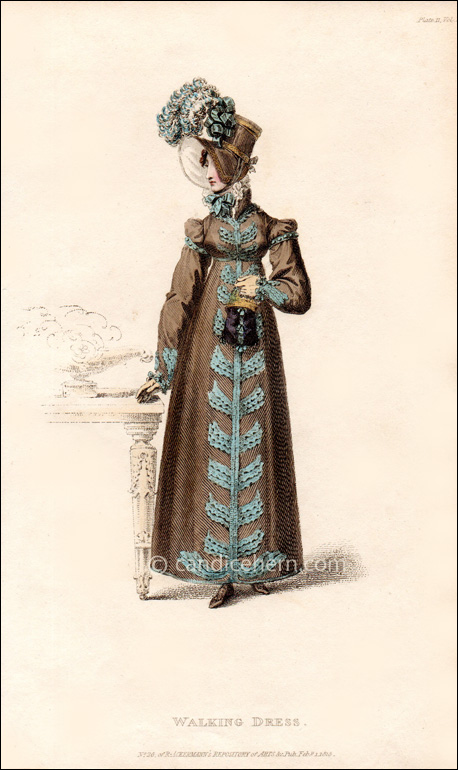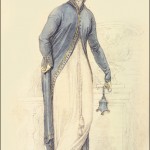Ackermann’s Repository of Arts, February 1818.
“Walking Dress.”
The description of this print describes in detail the dress under the pelisse, which we cannot see. The beautiful pelisse is the star here. I suppose the fashion editors wanted to suggest the type of dress that would have been worn with this pelisse. The dress sounds quite lovely. I wish we could see it!
The most striking feature of the pelisse is the blue ornamentation against the brown fabric. It is embroidered with a combination of blue ribbon and chenille. Gorgeous!
The style of the pelisse is in keeping with the current fashions: very high waist, loose sleeves confined at the wrist, and the shoulders given emphasis, here with short half-sleeves confined with blue buttons. Shoulders will continue to be given more and more prominence until they explode to ridiculous (to my eye) poufs in the late 1820s.
The print is described in the magazine as follows:
“A fawn-coloured poplin round dress: the body is of a three-quarter height; it is cut byas and has no seam, except under the arm. The back is narrower than last month; the fronts just meet, but do not cross; the sleeve is long, rather loose, and confined across the wrist by a satin piping disposed in waves; they are about two inches in length, and are finished by a small silk tuft at the end of each wave. The bust is trimmed to correspond, and the skirt is finished round the bottom by three rows of satin pipings, which form a deep wave, and which are also finished by tufts.
“Over this is worn a pelisse composed of fine fawn-coloured cloth, and lined with white sarsnet. The waist of the pelisse is of a moderate length, the body is tight to the shape, and it has a small standing collar. The trimming which goes down the front, and finishes the bottoms of the sleeves, is extremely tasteful; it is an embroidery composed of intermingled blue ribbon and chenille, which has a very striking effect. The sleeve is rather wide, except at the wrist, and is finished by a half-sleeve in the Parisian style; that is to say, very full on the shoulder, and confined across the arm by a row of small silk buttons. Head-dress, a bonnet composed of satin to correspond with the colour of the pelisse, lined with white sarsnet, and elegantly ornamented with a light embroidery in straw. For the shape of the bonnet, which is singularly becoming, we refer our reader to our print: it is trimmed with blue satin ribbon and a large plume of feathers. Limerick gloves, and half-boots composed of fawn-coloured kid.”








